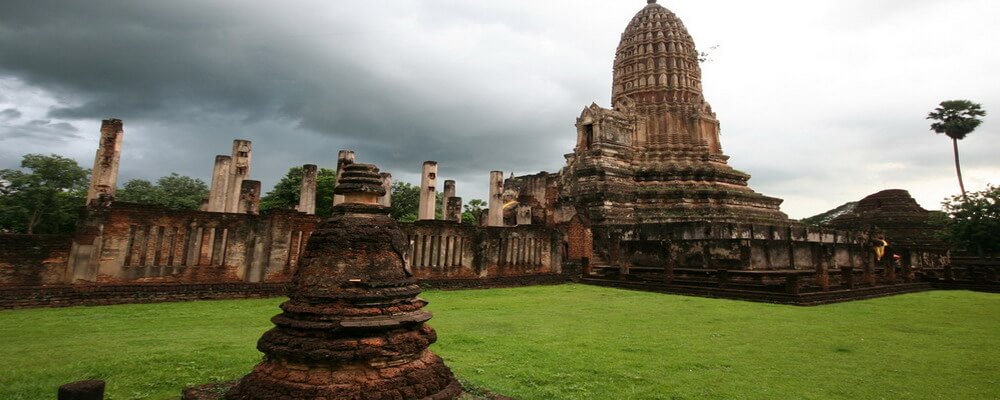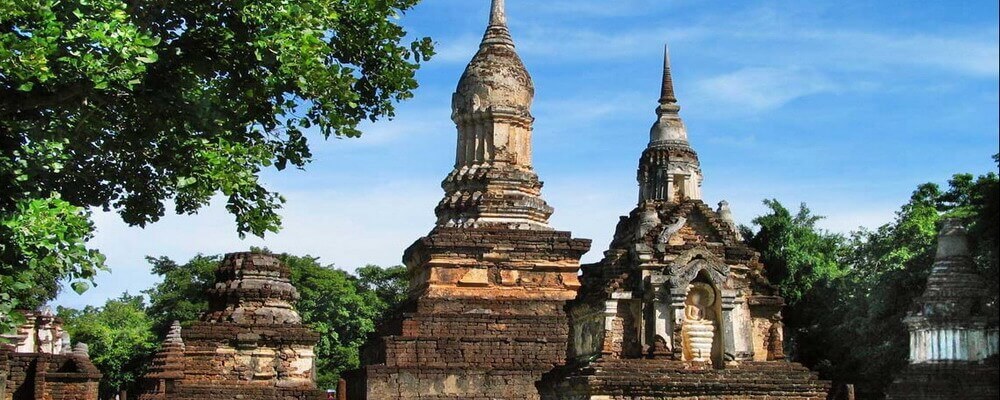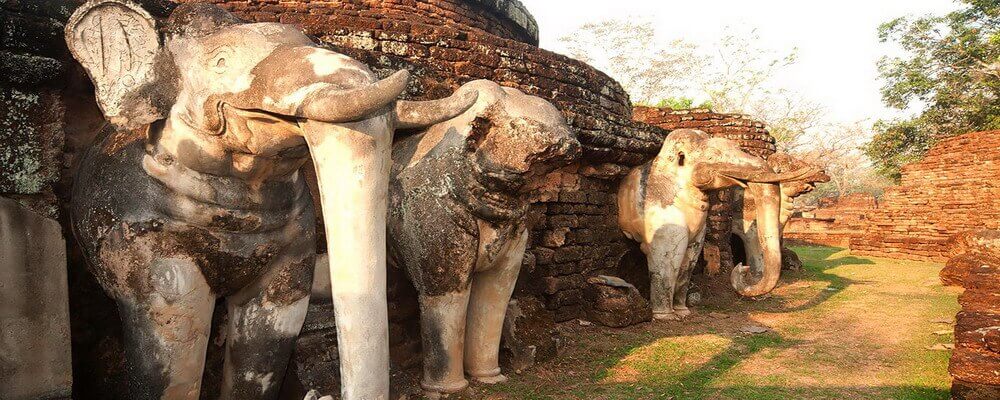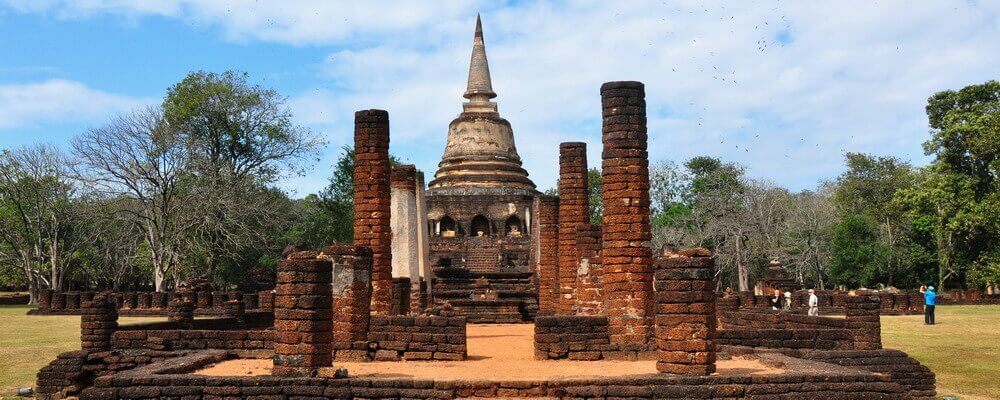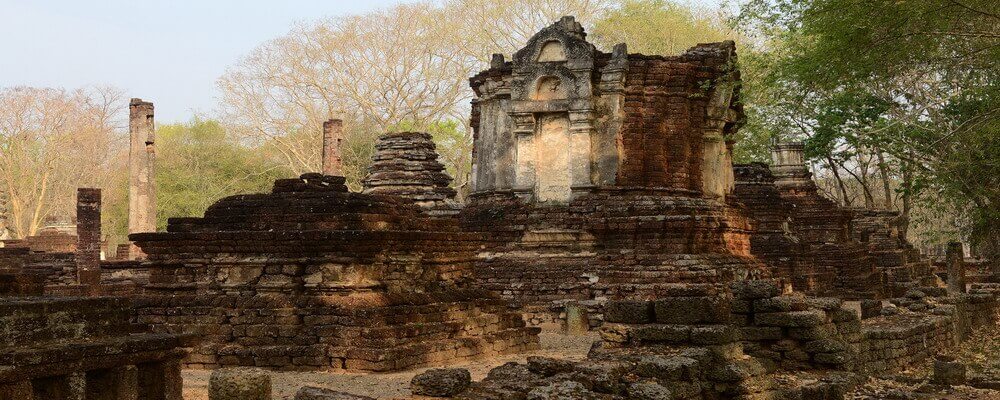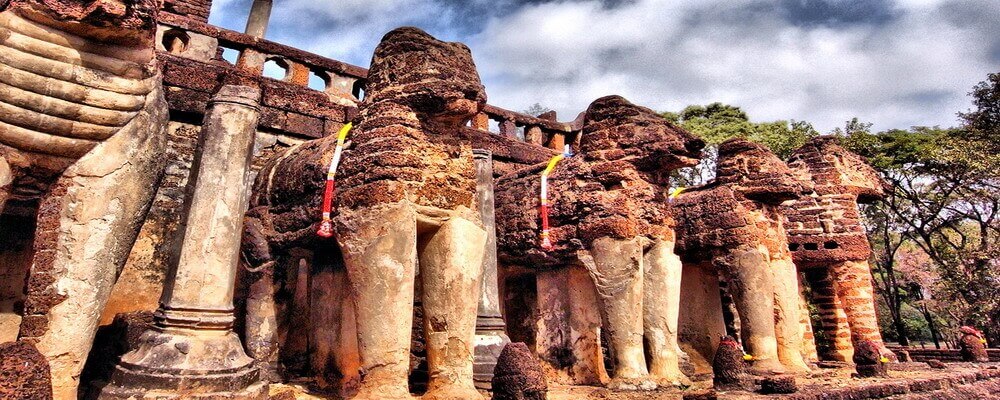 Si Satchanalai Historical Park
Si Satchanalai Historical Park
Si Satchanalai Historical Park is located on the west bank of the Yom River, in the district of Si Satchanalai, Sukhothai province, in northern Thailand. The park contains the remains of the ancient cities of Si Satchanalai and Chaliang. Si Satchanalai, which means city of good people, was founded in 1250 as a vassal city of Sukhothai Kingdom and new administrative centre in place of Chaliang, the ancient city, under Khmer influence, which reigned in the area previously. Chaliang, meaning city of water, was built before the 13th century, on the banks of the Yom River, from Thai migrated to the upper valley of the Chao Phraya River, in a strategic position for trade between China and the Khmer Empire. The city became an important west outpost of the Khmer Empire, with many temples in style of Angkor and a Royal Palace. The city had a substantial autonomy under the Khmer Empire until 1180, when the city of Sukhothai, it also Khmer's vassal, with its local governor, Pho Khun Sri Naw Namthom, began to gradually take control of Chaliang. In 1238, Prince Pho Khun Bang Klang Thao of Sukhothai declared its independence from the Khmer Empire, taking the name of Sri Indraditya, and founding the Sukhothai Kingdom. In 1239 Chaliang it was conquered by Sri Indraditya and subject to Sukhothai. During the reign of Sri Indraditya, in 1250, a new city was built in the area west of Chaliang as new administrative centre and was named Si Satchanalai. Sri Indraditya sent his son, the Crown Prince Ban Muang, to govern the city. Later also Ban Mueang, once you become King, appointed his brother, the Prince Ram Khamhaeng, governor of Si Satchanalai, beginning in fact the tradition of the city to have a crown prince, or heir to the throne, as governor. The city was granted the status of princely city and became the second largest city of the Kingdom. Si Satchanalai had a rapid urban development and cultural heritage, thanks to its strategic position for the defence of Kingdom to the north, and for his willingness to trade. This prosperous period began in the 13th century and continued until the 16th century, with its peak in the 14th century, well beyond the golden period of the Kingdom of Sukhothai. In 1378 the sovereign Boromaraja I of Ayutthaya conquered Sukhothai, thus determining the end of its Kingdom. In the turbulent period following Si Satchanalai was first conquered by sovereign Tilokarat of Chiang Mai, renamed Chiang Cheun and subject to the Lanna Kingdom, in 1451. In 1474 sovereign Trailokkanat of Ayutthaya recaptured the city, renaming it Sawankhalok, subjected to Ayutthaya Kingdom, maintaining its commercial and defence use for the new Kingdom. The city became a thriving centre for the production of ceramic Sangkhalok, both to the royal court of Ayutthaya to for export to overseas countries, such as China, Japan, Malaysia, Philippines and Indonesia. In 1766, during the war Burmese-Siamese from 1765 to 1767, the Burmese army advanced from Lampang and conquered Si Satchanalai, destroyed it almost entirely. After the war the city was rebuilt in the area of the new Sawankhalok, people abandoning the old city that was forgotten. In 1907 Crown Prince Vajiravudh, the future Rama VI, visited for two months the archaeological sites of Kamphaeng Phet, Sukhothai, Si Satchanalai, Nakhon Sawan, Uttaradit and Phitsanulok, to promote the study of history and archaeology of the area. It was during this journey that the Prince found in Si Satchanalai the remains, head, hand and feet, of a precious image of Buddha in bronze plated with gold, known as Phra Ruang Rodjanarith. The image, whose full name is Phra Sri Indraditya Ruang Rodjanarith Dhammobhas Mahavajiravudh Raj Poojaneeya Bophit, was restored by Prince Vajiravudh, between 1911 and 1913, and is now installed in the front of the Phra Pathom Chedi in Nakhon Pathom. In 1958 King Bhumibol and Queen Sirikit visited Si Satchanalai, Chaliang and Sawankhalok, to promoting the protection and restoration of the area. In 1976 the restoration project was approved. In the following years 134 structures have been discovered in the area, allowing, in July 1988, the official opening of the Historical Park of Si Satchanalai. On December 12, 1991 the park was declared a World Heritage Site by UNESCO, along with the historic parks of sister cities Sukhothai and Kamphaeng Phet. The park is located on the west bank of the Yom River in a natural wooded area. The ruins are divided into four main sites, and include the inner city, of Sukhothai period, the Khmer ruins of Chaliang at east of the city, previous of Sukhothai era, the remains of ancient kilns for the Sangkhalok ceramics, to the north along the river, and some other temples to the west, outside the walls. The inner city, within the old walls, is between the banks of the Yom River and the hills, the exhibits date from the 13th and 14th century. The temples are similar to those found in Sukhothai Historical Park, but on average less well preserved; only some temples have been renovated and restored to their original splendour. Among the most interesting are the Wat Chang Lom, Wat Chedi Chet Thaew and Wat Nang Phaya, all within the ancient walls. The ruins of Chaliang are a little more than two kilometres to the east of the walls of Si Satchanalai, in a bend of the Yom River. As evidence of the period Chaliang remain bastions of land with walls in laterite and the famous Wat Phra Si Rattana Mahathat, in Khmer-style; of the Royal Palace, probably built of wood, unfortunately no trace remains.
Admission & opening hours: the park is opens daily from 08:00 until 17:00. The ticket costs 150 THB and permit access to all historical artefacts. A map of the park and brochures in English are available at the information centre at entrance of park, accessible by a bridge across the river, about in the centre of the old city walls.
Getting around Park: the central area of Park, inside the old city walls, is small and it can be easily explored on foot, and it is also available a tram service. One option to get around between the four areas of the park is rent a bike at the information centre, it costs is about 40 THB per day.Read More
Info
- Address: Tambon Mueang Kao, a.k.a. Kaeng Luang, Si Satchanalai
- Telephone: +66 55 901 714
- Website: www.tourismthailand.org
Dinamic Map
Si Satchanalai Historical Park Highlights
Wat Phra Si Rattana Mahathat, also named Wat Phra Borommathat Chaliang Mueang or Wat Phra Prang, is one of the oldest temples of Si Satchanalai Historical Park, a perfect example of Khmer, Sukhothai and Ayutthaya styles. The temple was built in 1237, before the Sukhothai era, when Chaliang was under the control of the Khmer Empire of Angkor. Wat Phra Si Rattana Mahathat was restored and enlarged during the Sukhothai and Ayutthaya eras, and is still an active monastery with a modern Ubosot and a Kuti, the residence of the monks. The temple is located east of the historic walled city of Chaliang, on a small peninsula surrounded almost entirely by the Yom River. The main entrance of the temple is through a low gate on the east side of the wall. The gate is surmounted by a column in the classic four-sided stone sculptures in Khmer style, similar to the face towers of the Bayon temple at Angkor. The beautiful Prang corncob shaped on square base is the main attraction of the temple. The structure is built of laterite blocks and covered with plaster, it dates back to the 15th century, in the Ayutthaya period, but it was probably superimposed on a pre-existing structure built in Khmer style. A steep staircase, in front of the prominent structure, leading to the cell in the middle of prang where was usually preserved the relics, here probably a Linga, a representation of Shiva. Around this main prang are several smaller chedis in various states of preservation. In front of the prang is the Viharn Luang Pho To, the main Assembly Hall of the temple, of this remain only the base and a few rows of pillars. On the back of the Viharn is a Buddha image, in Sukhothai style, in cross-legged position known as Bhumisparsha Mudra, or as Subduing Mara. Behind the prang are the remains of a chedi, called Phra That Mutao, which is the oldest structure in the temple, probably dating back to the Mon Dvaravati era. The chedi is built in laterite blocks on an octagonal base of different levels, with a steep staircase that leads to a cell relic; the upper part of the structure collapsed. Behind the Phra That Mutao there are the remains of another smaller viharn, known as Phra Viharn Song Phi Nong, which literally means the viharn of the two brothers, referring to the two large images inside. Near this viharn is a Mandapa, or Mondop in Thai, a structure with a square base built of laterite blocks and covered with stucco. The mandapa enshrines a large standing Buddha image, known as Phra Attharot. These images of the Buddha were very popular in the Sukhothai period, you can find a similar in the mondop of Wat Mahathat in Sukhothai Historical Park.Read More
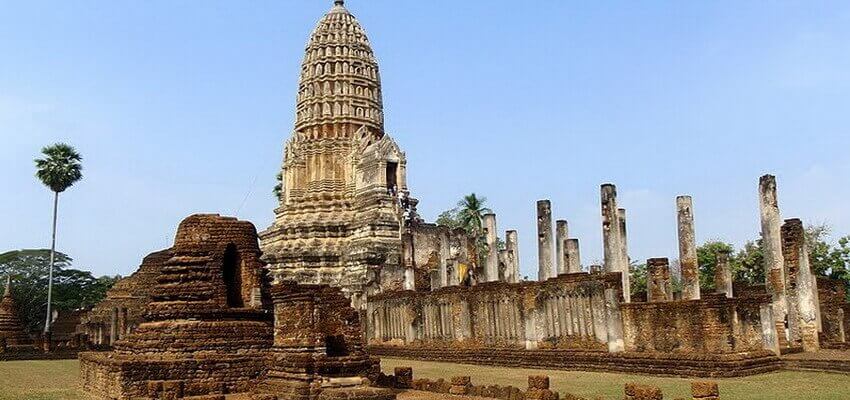
Wat Chedi Chet Thaeo, or Wat Chedi Jet Thaew, is the largest temple and main attraction at Si Satchanalai Historical Park. The temple compound, which literally meaning temple with seven rows of chedis, is in the central zone of old city walled. It was built during the reign of King Li Thai, likely between 1340 and 1350, and it consists of numerous monuments in various styles. The temple complex has architectural features influenced by Khmer, Mon, Burmese, Lanna and Sukhothai style. The Wat Chedi Chet Thaeo is surrounded by a boundary wall with four gates; the main entrance is located opposite the chedi of Wat Chang Lom. The complex comprises of a principal chedi, a viharn and 32 subordinate chedis. The large number of chedis in the temple, suggest that the complex was also funerary temple, where were stored the ashes of the rulers Si Satchanalai. The main lotus-bud chedi is located about right in the centre of complex, on a high base of five square receding tiers. The chedi, in Sukhothai style, is surrounding by a gallery with remains of mural paintings of the Buddha, and is topped with a concentric spire. In front of the main chedi are the remains of the Viharn, the assembly hall, of this can still be admired the base and a part of the columns that supported the roof. Inside the wall of the temple are the other 32 smaller chedis in various architectural styles, including lotus bud chedis, in Sukhothai style, prasat stupas, in Khmer style, and bell shaped stupas, in Sinhalese style; many have niches enshrining images of the Buddha in various postures. On the north side, close to the entrance, stands an interesting smaller chedi which is house, in a niche, of a well preserved Buddha image in gesture of meditation. A Naga snake supports the image, its seven coils swirl around the back of the Buddha, while its nine heads cover the Buddha's head.Read More
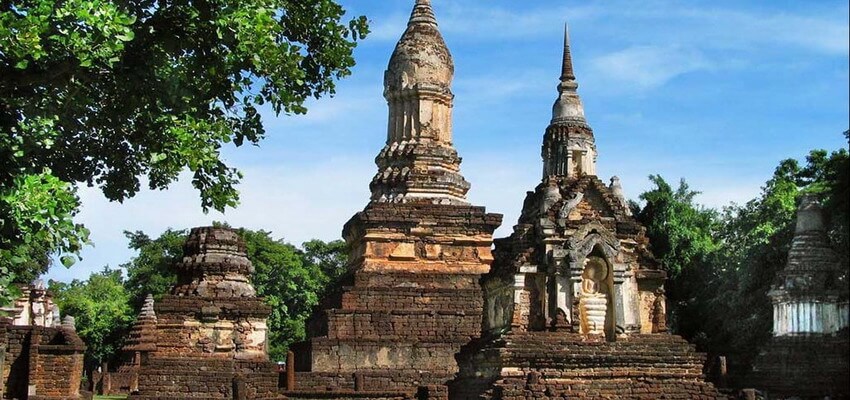
Wat Chang Lom, which literally meaning the temple surrounded by elephants, is located in the central area of Si Satchanalai Historical Park, in the walled old city, near the Yom River. The temple dates back to the 14th century, during the Sukhothai period, and consists of a large main chedi, two viharns and a chedi subsidiary. The most attractive structure of Wat Chang Lom is its bell-shaped chedi, in Sinhalese style, set on an imposing two tiered base. The first level is surrounded by 39 statues of entire elephant's body, which seem to support the upper structure; four of them, those places to the cardinal points, are decorated with care. A flight of stairs leads to the upper deck surrounded by 20 niches containing statues of the Buddha, in the position called Bhumisparsha Mudra, a feature inspired by the Mon architecture. A railing in the form of snakes surrounds all this level of the structure. On top of the second tier stands the bell-shaped chedi, in Sinhalese style, topped with a tapering finial. Just below the spire of the chedi are relieves images of walking Buddha. In front of the chedi are the remains, the base and some of pillars that supported the roof, of main viharn of temple, the assembly hall. Other ruins of smaller assembly hall and the remains of a smaller chedi are at southeast of the main chedi. Read More

Wat Nang Phraya, or Monastery of the Queen, is located within the central area of the Historical Park of Si Satchanalai, close to Ram Pratu Narong gate, the South Eastern gate of the ancient city walls. The temple dates from the 15th century, the period when the city was under vassalage of Ayutthaya and was renamed Sawankhalok. Wat Nang Phraya consists of a main chedi, a viharn, a ubosot chedis and two subordinates, collected within a laterite wall. The main attractions of the temple are the stucco relieves, well preserved, which can be seen in a section of the wall of the viharn that remain upright. The fine stucco decorations, with floral designs, are reminiscent of carved panels of wood, typical of the Lanna temples of northern Thailand. The main chedi of temple, in Sinhalese style, is supported by a high base, once probably decorated with sculptures of elephants similar to Wat Chang Lom. A steep staircase leads to a narrow arched entrance, which allows access to a cell relic. The bell-shaped chedi is topped with an amalaka and a tall tapering finial.Read More
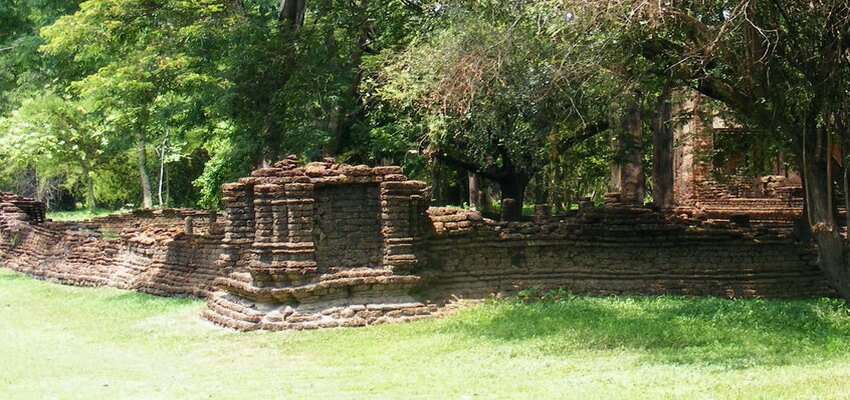
Wat Khao Phanom Phloeng is located atop a hill in the central area of the Historical Park of Si Satchanalai. A staircase of 144 steps, in laterite blocks, leads to the top of the wooded hill, from which a good part of the old walled city. Wat Khao Phanom Phloeng, which literally can be translated into the temple of the sacred mountain fire, dates from the 13th century to the beginning of the Sukhothai period. The temple structures that remain include a small bell-shaped Chedi, a pretty Mondop, or Mandapa, and what remains of a Viharn. The most perfectly preserved is the little Mondop, known to locals as the Sanctuary of Chao Mae Ong Sam Lee, and is the only structure of the temple is not dedicated to the Buddha. The laterite structure with a roof shaped like a pointed arch stands on a high square base. A staircase leads to its arched entrance that allows access to the interior room, full of pictures of Chao Mae La Ong Sam Lee and a number of colourful dresses, brought here, even today, by many of the faithful to the Goddess. Little remains of the Viharn, just the base and a few rows of pillars that supported the roof. On the back of ruins is a large laterite Buddha image, covered with stucco, in the cross-legged position, known as Subduing Mara, Calling the Earth to Witness. The bell-shaped chedi, in Sri Lanka style, is made of laterite blocks, on a high square base. The small bell is surmounted by a amalaka, a stone disc; the spire at the peak is collapsed.Read More
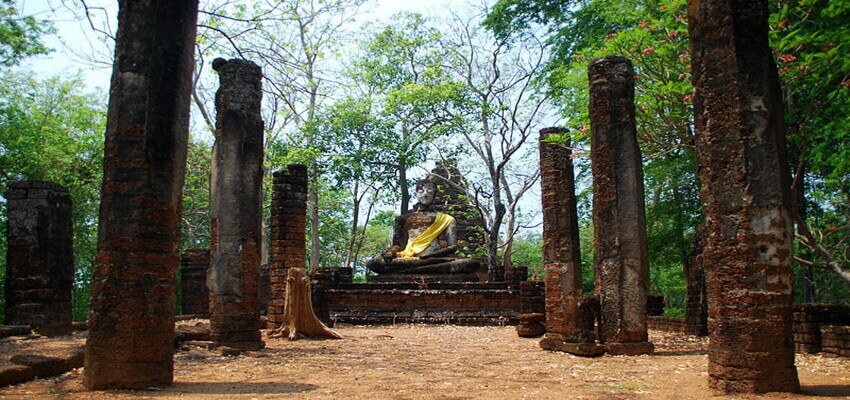
Wat Khao Suwan Khiri is located on the highest hill within the walled area of Si Satchanalai. The temple, whose name means Temple of the Golden Hill, can be reached by climbing from Wat Khao Phanom Phloeng, 200 meters to east, or following a trail to west, along the ridge of the hill. Of the temple remain few ruins, but the view of the old walled city of Si Satchanalai, the river and surrounding countryside is breathtaking. The main attraction of temple is a large well preserved bell-shaped chedi in Sinhalese style, standing on a base of four square receding tiers and a single octagonal tier. The bell is topped with a amalaka, a disc stone, and a tapering finial. In front of the chedi are the remains of the large principal viharn, the assembly hall, the base and some pillar. Other structures on the site include a subordinate chedi and another smaller viharn.Read More
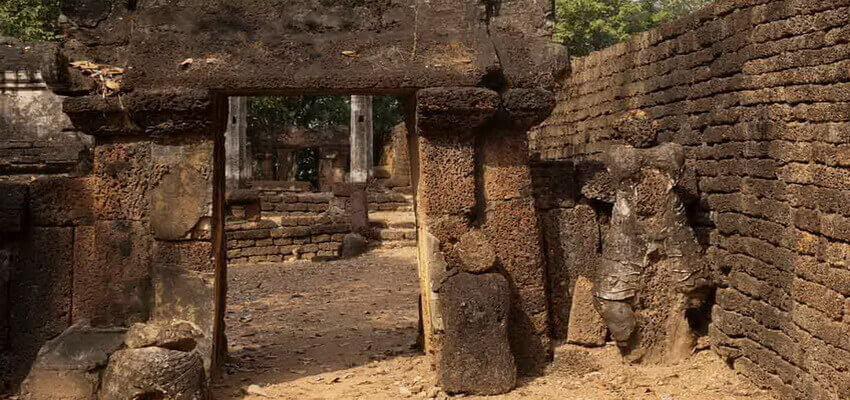
Wat Chom Chuen is located in Chaliang, near the banks of the Yom River, a few kilometers east of the city wall of Si Satchanalai. The oldest parts of the temple dates back to the 13th century, during the period when Chaliang was still a vassal of the Khmer Empire, and were built on even older structures, probably dating back to the Dvaravati era. Wat Chao Chan consists of a central sanctuary, a Prasat in Khmer style, a Ubosot and a Mandapa, or Mondop in Thai. The prasat is the oldest structure in the Wat Chom Chuen, built during the reign of Jayavarman VII, of Angkor, in blocks of laterite covered with plaster, in Bayon style, probably for enshrine a relic of the Buddha. The prasat has portals on all four sides, but only one to the east allows access to the cell relic inside, the other three sides contain false entrances, a feature often seen in Khmer architecture. The mondop and the viharn were built later, during the era of Sukhothai. The viharn was built in laterite blocks, but collapsed and of it remains only the base and part of the roof pillars. Behind the prasat stands the mondop, that preserve inside a large image of Buddha named Phra Attharot, similar one can be found at the Wat Phra Si Rattana Mahathat, but in worst conditions of preservation.Read More
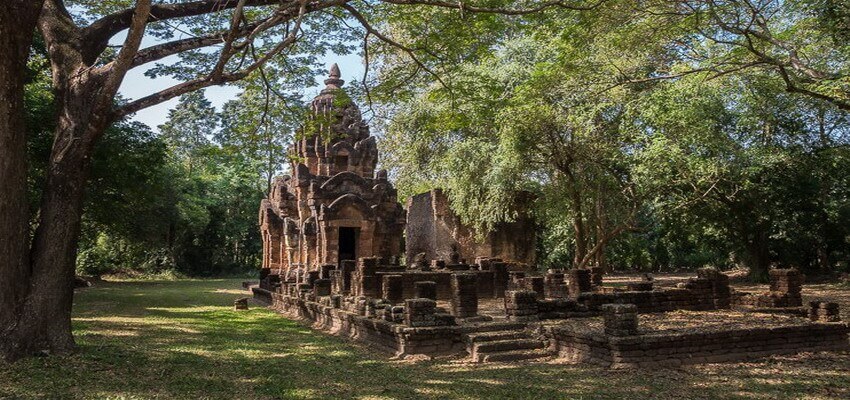
Si Satchanalai has been, throughout its history, a thriving centre for the production of ceramic Sangkhalok, both to the royal court of Ayutthaya to for export to overseas countries, such as China, Japan, Malaysia, Philippines and Indonesia. In ancient times, hundreds of huge pottery kilns were built along the Yom River, in the area near the old town of Si Satchanalai. The ceramics Sangkhalok take their name from Sawankhalok, the name by which it was renamed Si Satchanalai during the period of vassalage to Ayutthaya. During the archaeological excavations have been found hundreds of kilns, some of these, in fair condition of preservation, are now visible at the sites of discovery along the Yom River, north of the old city walls. A particularly large, about 8 meters wide, oval-shaped with curved roof is exposed within the Celadon Kiln Site Study and Conservation Centre in the village of Ban Ko Noi, 6 Km north of Si Satchanalai Historical Park, along the Highway 1201. In the Centre they are exhibited fine ceramics, pottery, vases and other ceramic objects found in the area, along with panels written describing the technique and the evolution of ancient ceramic Sangkhalok. Admission & opening hours: the museum is open every day from 09:00 to 16:00. Admission is 50 THB per person.Read More

 Get to Si Satchanalai
Get to Si Satchanalai
Getting there: Park is located on the West bank of the Yom River at Tambon Muang Kao, which is 11 Km off Si Satchanalai towards Sawankhalok, 54 Km at North of Sukhothai, and 466 from Bangkok. To reach Si Satchanalai you can use plane, bus or private car. The nearest airport to Si Satchanalai is the Sukhothai Airport, only 29 km away, from where you can easy continue your journey with songtaews or taxi. There aren't direct buses to Sri Satchanalai from Bangkok, you have to use the ones that reach Sukhothai. Buses to Sukhothai from Bangkok leave from the Northern Mo Chit Terminal, with hourly departures, the trip takes about 7 hours and the ticket costs from 250 to 380 THB, depending on the class. The bus journey from Sukhothai to Si Satchanalai takes just over an hour and costs about 60 THB. Buses depart every half-hour from the bus terminal on Jarot Withithong Road, in the north-west of Sukhothai. In Si Satchanalai there are two stops, the second is closer to the park entrance, across the river, just ask the driver what it's better for the park.
Path Sukhothai - Si Satchanalai: the quickest and most convenient way to reach Si Satchanalai from Sukhothai by car, owned or rented, is follow northbound Highway 101 for 57 Km. The trip takes about an hour. The car can easily be chartered in Sukhothai, about 1000-1300 THB per day. The rate of hiring a private taxi varies depending on your ability to bargain, roughly about 2000 THB for a whole day.
Find the best Hotel in Thailand at "Lowest Price"





